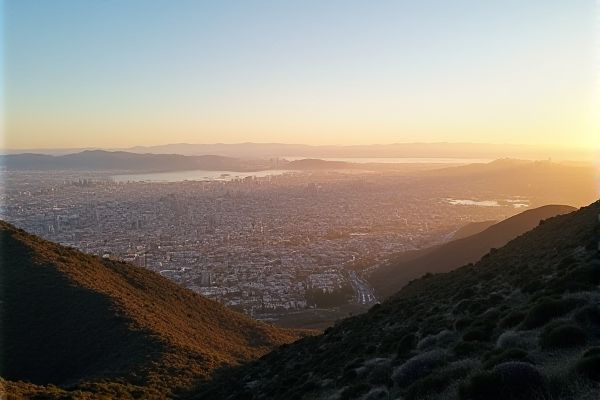
Transportation and commuting in California: Extensive public transportation network. Car-heavy culture in urban areas. HOV lanes for carpools. Traffic congestion in major cities. Biking-friendly communities. Ride-sharing services widely available. Electric vehicle incentives. Coastal trains like Amtrak Pacific Surfliner. Cycling paths in major cities. Variety of commuter train options.
Extensive public transportation network.
California boasts an extensive public transportation network, including comprehensive bus and rail services managed by major agencies like Metro, OCTA, and RTA, covering urban, suburban, and rural areas with light rail lines, subway lines, and commuter rail systems like Metrolink, connecting multiple counties and cities efficiently. The network also includes various local and intercity bus services, as well as high-speed rail projects aimed at linking major metropolitan areas.
Car-heavy culture in urban areas.
California's urban areas are characterized by a car-heavy culture, leading to the development of suburbs, urban freeways, and infrastructure such as stores and malls with parking lots, drive-in restaurants, and significant issues with traffic congestion and smog. This automobile-centric environment is particularly evident in cities like Los Angeles, where the impact on the urban landscape is most pronounced. The reliance on cars has shaped the way cities develop, affecting everything from urban planning to daily life, highlighting both the conveniences and the challenges of a region dependent on automotive transportation.
HOV lanes for carpools.
In California, particularly in Los Angeles, High Occupancy Vehicle (HOV) lanes are reserved for vehicles carrying two or more people, including child passengers, and are active 24/7, with exceptions for certain vehicles like motorcycles, mass transit vehicles, and clean-air vehicles with specific decals. These lanes are critical for traffic flow efficiency and reducing congestion on major highways. Violating HOV lane rules can result in a significant fine, emphasizing the importance of adhering to the regulations. For detailed information, visit the RKM Law website to understand who is allowed to use the carpool lanes in Los Angeles and the consequences of non-compliance.
Traffic congestion in major cities.
In California, major cities have shown varied trends in traffic congestion. While Los Angeles saw a significant decline in average daily vehicle miles traveled (VMT) and no increase in congestion since 2019, the San Francisco metro area experienced a decline in VMT and a slight decrease in congestion. Conversely, cities like Stockton, Riverside, and Fresno saw significant increases in VMT and moderate rises in congestion. For a detailed understanding of these trends, the San Francisco metro area offers insights into how different urban dynamics influence traffic patterns. Such variations highlight the complex interactions between population growth, infrastructure development, and commuting behaviors in shaping urban mobility.
Biking-friendly communities.
California boasts several biking-friendly communities, with cities like Mountain View, Albany, and Davis leading the way with high Bike Scores, extensive bike lanes, and cyclist-friendly infrastructure, making them ideal for both commuters and recreational cyclists. For more insight into these locations, you can explore the Most Bikeable Cities in California to discover the top spots for cycling enthusiasts.
Ride-sharing services widely available.
Ride-sharing services such as Uber, Lyft, Blacklane, and Carmel are widely available in California, including in major cities like Los Angeles and San Jose, with strict regulations in place for driver background checks, vehicle inspections, and insurance requirements to ensure passenger safety.
Electric vehicle incentives.
The Clean Vehicle Rebate Project (CVRP) in California, which previously offered rebates up to $7,500, has closed its doors to new applications as of November 8, 2023. However, there are still various incentives available to encourage the adoption of electric vehicles in the state. Programs such as the Clean Fuel Reward Program, along with local rebates, continue to provide financial support. Additionally, the federal EV tax credit, offering up to $7,500, remains an attractive incentive for potential electric vehicle owners. For those interested in exploring these opportunities, visiting the Coltura website can offer valuable information and guidance.
Coastal trains like Amtrak Pacific Surfliner.
The Amtrak Pacific Surfliner is a passenger train that travels a 351-mile route through San Diego, Orange, Los Angeles, Ventura, Santa Barbara, and San Luis Obispo counties, offering comfortable seating, free Wi-Fi, and scenic coastal views. With 26 daily trains and nearly 3 million annual riders, the Pacific Surfliner provides a convenient and picturesque travel experience for those exploring Southern California.
Cycling paths in major cities.
California's major cities, such as Mountain View, Palo Alto, and Santa Monica, are highly bikeable with extensive networks of bike lanes, cyclist-friendly neighborhoods, and numerous attractions accessible by bike, making them ideal for commuting and recreational cycling. For more information about these cities and what makes them perfect for biking enthusiasts, visit the Most Bikeable Cities In California for a comprehensive guide.
Variety of commuter train options.
California offers a diverse range of commuter train options, including the COASTER in San Diego, Metrolink connecting major cities across multiple counties, Caltrain in the Bay Area, and Amtrak's Pacific Surfliner, California, and San Joaquin lines for intercity travel. If you're planning a trip and need more information on navigating these options, you can visit Study California for comprehensive travel tools and guidance to help you get around and make the most of your journey in the Golden State.
